Life style
Eating right and playing well

Optimum performance in competitive sports depends on multiple factors and ‘guided diets’ play a decisive role if sportsmen and women are to shine in the international sports arena says, Dr. Ranil Jayawardena, Senior Lecturer and Consultant Clinical Nutritionist from the Faculty of Medicine, University of Colombo and Visiting Fellow at the School of Exercise and Nutrition Sciences, Faculty of Health, Queensland University of Technology, Australia, in an interview with the Sunday Island.
by Randima Attygalle
While training is crucial in competitive sports, along with the sport culture of a particular nation, additional support both mentally and physically shape an international sports star. Added to this are sports psychology, injury prevention recovering support and proper nutrition. “Unlike when indulging in leisure sports, competitive sports demand sophisticated meal patterns and proper supplements for best results which include quick recovery, injury prevention, weight management and general health and wellbeing,” says Dr. Ranil Jayawardena.
In the absence of specialized ‘sports nutritionists’ here at home, many naturally rely on the advice of their ‘seniors’ or online material. “However, each individual requires a personalized dietary schedule depending on his/her socio-economic circumstances, training schedule, body weight, age, gender and the event calendar. For example what a gymnast requires is very different to what a marathon runner needs,” says the Specialist who goes onto add that there is no one diet or supplement for everyone. “One simply cannot generalize advice,” he reiterates.
Getting one’s hydration right is one of the easiest and cheapest nutritional strategies to optimize performance, yet Dr. Jayawardena says it is still one of the commonly overlooked factors by sportsmen. “Hydration is essential for both physical and mental faculties and this involves pre-hydration, during hydration and post-hydration.” Properly corrected Oral Rehydration Solutions such as Jeevani or fruit juices with salt and sugar are recommended here. “One doesn’t need expensive readymade isotonic formulas for proper hydration,” points out Dr. Jayawardena who explains further that sportsmen and women indulging in intense training must monitor their pre and post training body weight to estimate the water loss which needs to be corrected accordingly. “Your urine colour is an indicator of the hydration status. If it is dark, you are still dehydrated. One kilo of body weight loss after a training session represents a need for 1.5 ltr of fluid to be replaced.”
What is traditionally accepted as healthy food may not work for those doing intense sports, notes the Nutritionist. “The body derives energy from carbohydrates, hence choosing the correct carbs is vital for best performance. For instance a pre-training lunch of unpolished rice, high fat meats and fibre-rich vegetables such as dark green vegetables can go against an athlete. These meals reduce the rate of absorption of carbohydrates. Abdominal cramps while exercising are often the results of unabsorbed foods in the gut.”
If a training session exceeds one hour, intermediate carbohydrate-rich food is recommended and post training meal too should contain right carbs to enhance recovering, Dr. Jayawardena explains. “While a simple breakfast of bread, jam and banana is recommended for pre-training breakfast, a lunch of white rice, dhal, eggs/chicken/fish without leafy vegetables is recommended for lunch followed by a sweetened fruit juice, banana, a bun or crackers after training for recovery. While vegetables rich in fibre are discouraged for pre-training lunch since they take time to digest, they are recommended for dinner or four hours before a training session.”
Proteins, as the Specialist remarks, are the ‘building blocks for muscle growth and repair.’ A constant breakdown and regeneration of muscle tissue occurs every day which needs to be fuelled by the dietary intake of protein. Although protein requirement depends on body weight, gender, sport etc, an average sportsman needs 1.2-2.0g protein per kilogram of body weight. However, not all proteins are the same, warns the Nutritionist. “While some proteins are of high quality with all essential amino acids, others are not so.”
Protein intake should also be distributed throughout the day instead of being ‘loaded’ with it only at night. “While meats, poultry, fish, eggs are rich in proteins, pulses and nuts have a high level of carbohydrates and fat contrary to the common belief that they have a high concentration of proteins,” points out Dr. Jayawardena.
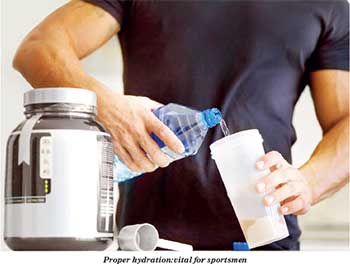 For competitive sportsmen and women, supplements are essential says the Nutritionist. These supplements however should be carefully selected on proper guidance either by a nutritionist or a sports physician, as some may contain banned substances for which they are tested nationally and internationally, he says. An overdose of them could also result in weight gain. “There are very safe Protein supplements including Whey protein, Casine protein, BCAA proteins, Amino acids capsules etc. If they select the correct product, they can be used to supplement and achieve daily protein requirements and help build muscle mass necessary for performance.” Reputed brands and reputed suppliers of the supplements are keys to safety, he adds.
For competitive sportsmen and women, supplements are essential says the Nutritionist. These supplements however should be carefully selected on proper guidance either by a nutritionist or a sports physician, as some may contain banned substances for which they are tested nationally and internationally, he says. An overdose of them could also result in weight gain. “There are very safe Protein supplements including Whey protein, Casine protein, BCAA proteins, Amino acids capsules etc. If they select the correct product, they can be used to supplement and achieve daily protein requirements and help build muscle mass necessary for performance.” Reputed brands and reputed suppliers of the supplements are keys to safety, he adds.
The supplements as Dr. Jayawardena explains, should be gradually introduced to a budding sportsman or woman, starting with very basic ones around the age of 16. “We don’t prescribe them at a very young age as this will impede their increase in performance at a more mature level. However, multi-vitamin mineral and iron supplements (latter especially for menstruating girls) are recommended depending on the individual requirement.” Vitamin D supplements are often recommended for those involved in indoor training (ex: squash, badminton, table tennis etc) to improve both bone and muscle health. “The urban Sri Lankan population is reported to be having Vitamin D deficiency as their exposure to the morning sunlight is minimum unlike the agrarian community of the country.”
He also warns of high doses of vitamin supplementations. “Very often we see them taking several multi-vitamins as well as high doses vitamins in isolation. Vitamin E is commonly abused since is no recognized deficiencies”
For vegetarians and vegans, pursuing an intense training sport could be a tough journey, observes Dr. Jayawardena. “Since their natural intake of proteins is very low, such people will have to rely on a very high intake of quality protein supplements. Maintaining body weight could also become challenging for vegetarians who tend to be partial to milk, curd, paneer and tofu rich in fat.”
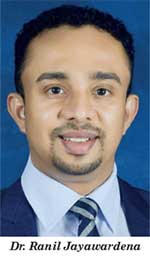 Fats from healthy sources such Omega 3 which is found in oily fish is highly recommended for those pursuing competitive sports. Moreover, Monounsaturated fatty acids are healthier compared to saturated fats. “Olive, avocado are also recommended provided there are no concerns about the body weight,” explains Dr. Jayawardena who urges to watch all fat types as they all contain a certain amount of calories.
Fats from healthy sources such Omega 3 which is found in oily fish is highly recommended for those pursuing competitive sports. Moreover, Monounsaturated fatty acids are healthier compared to saturated fats. “Olive, avocado are also recommended provided there are no concerns about the body weight,” explains Dr. Jayawardena who urges to watch all fat types as they all contain a certain amount of calories.
Understanding what and when to eat on a daily basis will have a huge impact on performance, mood, sleep, health and energy levels which should never be underestimated, says the specialist. Adding a variety of fruits and vegetables to the daily diet (at least two fruits and three vegetables per day) and two dairy products is essential.
Dr. Jayawardena, with his global exposure to sports nutrition, lobbies for both academic and professional intervention in this field locally. Voicing his concerns over the lack of ‘sports nutrition education’ in the country Dr. Jayawardena remarks: “it is still not part of our local medical curriculum. We only deliver it as a voluntary module which should not be the case,” Citing the Australian experience of a qualified sports nutrition education system complete with exercise physiologist, sports nutritionists and sports psychologists, he calls for intervention at national level at a time when the demand for such professionals is overwhelming to take the Sri Lankan sporting talent to the next level.
- News Advertiesment
See Kapruka’s top selling online shopping categories such as Toys, Grocery, Flowers, Birthday Cakes, Fruits, Chocolates, Clothing and Electronics. Also see Kapruka’s unique online services such as Money Remittence,News, Courier/Delivery, Food Delivery and over 700 top brands. Also get products from Amazon & Ebay via Kapruka Gloabal Shop into Sri Lanka.
Life style
LUXASIA aims to lead luxury beauty’s growth in Sri Lanka
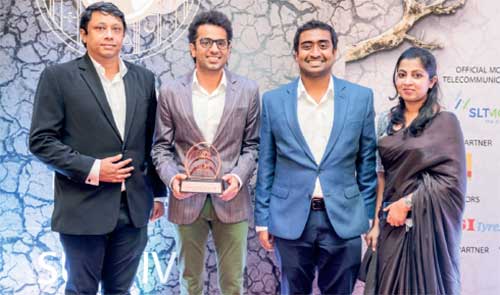
Sri Lanka is a land renown for stunning natural beauty. Yet, LUXASIA still managed to usher in a different kind of beautiful to the market through its expertise in luxury beauty retail and omni-distribution.
In November 2019, LUXASIA unveiled its inaugural classy beauty counters at Odel, One Galle Face. Since then, it has brought enchanting fragrances from luxury brands such as Burberry, Calvin Klein, Gucci, and Marc Jacobs, as well as trendy skincare from KORA Organics to beauty-lovers in an exquisite and captivating retail format.
Now, having successfully overcome the challenges in 2020 imposed by COVID-19 and related lockdowns, LUXASIA is ready and excited to thrill Sri Lankan consumers again. This time, it is with the launch of both skincare and make-up collections from the prestigious Japanese beauty brand, Shiseido. Arriving with a glamorously magnificent pop-up at One Galle Face from 8 to 14 February 2020, LUXASIA promises to bring memorable consumer experiences and a feast for the eyes that showcases the best in Japanese beauty.
Leading up to this pop-up, LUXASIA partnered the Key Opinion Leaders (KOLs) and top influencers of Sri Lanka to excite the beauty community with a sneak peek of what Shiseido have to offer. This campaign garnered more than 100,000 social interactions, with over 1.2 million social media impressions, piquing consumers’ fascination in Shiseido’s award-winning and best-selling serum, The Ultimune Power Infusing Concentrate.
Looking ahead into 2021, LUXASIA aims to continue delighting consumers with even more fresh retail innovations to spice up the luxury beauty scene in Sri Lanka. Soon, fragrance enthusiasts can expect a unique pop-up of all the scents that Luxasia carry, featuring new launches from Davidoff and Calvin Klein, as well as other interesting novelties. Beauty-lovers can also expect more limited edition products and gifts-with-purchases, interesting workshops, as well as seasonal offerings in the coming months. Concurrently, LUXASIA also aspires to continue grooming the Sri Lankan beauty community through more entertaining collaborations with KOLs throughout 2021.
LUXASIA sees immense potential in Sri Lanka’s fast-growing beauty market and has been its voice in the international beauty industry. For some time now, LUXASIA has been relentlessly reaching out to numerous luxury beauty brands across to world to interest them in Sri Lanka. While it is encouraging to see the first-fruits, LUXASIA is aiming much higher. Forging ahead, LUXASIA strives to champion and lead the growth of luxury beauty in Sri Lanka, through even more partnerships with great brands, and by continuously delighting consumers.
Life style
Newly published guide opens many windows on whale watching
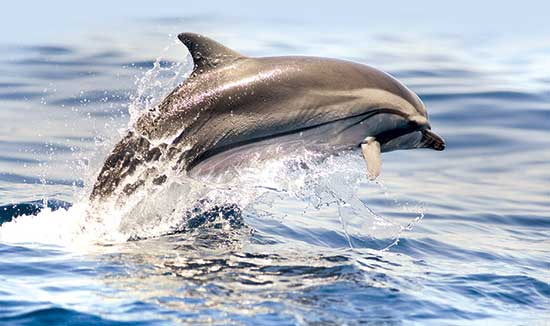
by Ifham Nizam
Shipping lanes to the south of Dondra pose the threat of ships colliding with whales as the area has very rich marine life which also attracts whale watching boats, says prolific wildlife writer and photographer Gehan de Silva Wijeyeratne, author of the recently published ‘A Naturalist’s Guide to the Mammals of Sri Lanka’.
He says international shipping industry organizations have written to the government to push back the existing shipping lanes and if no action is initiated, there is the danger of whale watching boats colliding with vessels.
Dr. Susannah Calderon and her colleagues at the University of Ruhuna have recommended the shipping lanes be moved 15 nautical miles south. The cost impact to all concerned will be negligible, but it significantly improves safety at sea, especially at night when the sea is dotted with the lamps from hundreds of small fishing crafts in the path of giant container carriers.
“It is primarily a safety issue though an important secondary impact will be that it reduces fatal collisions with whales, while generating favourable publicity for the government of Sri Lanka. It boils down to moving the shipping lanes further south and saving lives, Wijeyeratne stressed in an interview with The Sunday Island.
Asked what’s special about his latest publication, he said: “This is the first photographic field guide which covers nearly all of the mammals found in Sri Lanka. It covers 96 per cent of the land and marine mammals. The book, which is portable and affordable, also contains a large number of images from 40 photographers which are practically useful in the field to identify 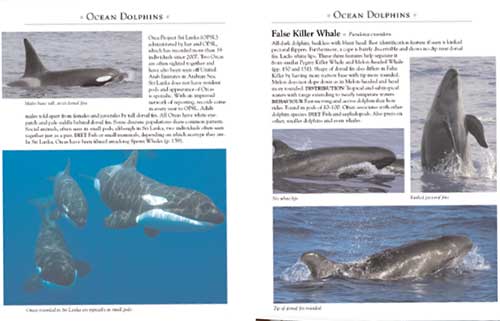 a mammal to species level. It also covers a number of small, discrete, nocturnal mammals whose existence that even many local wildlife enthusiasts will not be aware of.”
a mammal to species level. It also covers a number of small, discrete, nocturnal mammals whose existence that even many local wildlife enthusiasts will not be aware of.”
On the book’s coverage of the marine mammals, Wijeyeratne said there are two noteworthy aspects. Firstly, it covers all the species recorded in Sri Lankan waters expect for one, the Omura’s Whale. This will be included in a second edition. Secondly, it uses images of the whales and dolphins (cetaceans) which will show the animals the way a whale watcher will see them on the surface.
Artwork that shows the whole animal is important, but in field conditions, they are often of limited value to identify cetaceans which only show a little of their upper body in sections at a time they surface.
Q: You were the first to publicize that Sri Lanka was the best location for Blue Whale sightings and offered the best chance to see a superpod of Sperm Whales. Can you explain briefly how you set about branding Sri Lanka as a top international destination for whale watching?
A:
I started with field work to ascertain the facts and launched a media campaign initially with Jetwing Eco Holidays and Jetwing Hotels which was supported over many years by the Sri Lanka Tourism Promotion Bureau (SLTPB) and others in the media and tourism business. I have published 37 articles on whale watching in Sri Lanka. The first, in May 2008, was pivotal as it boldly stated that Sri Lanka was best for Blue Whales. This set everything in motion. My articles give due credit to many people who were a part of this amazing story. This includes Dr. Charles Anderson who first told me it would be feasible to see Blue Whales from the South.
A Belgian millionaire philanthropist who prefers to remain anonymous and helped create the infrastructure for whale watching by 13 tsunami affected fishing youth who set up Mirissa Water Sports and Sue Evans who was important for connecting all of us and Anoma Alagiyawadu (the Jetwing Lighthouse Naturalist) whom I tasked with collecting the initial data for the Encounter Rates I publicized in the media.
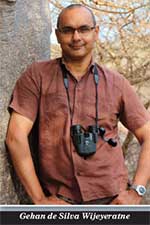 Remarkably, no Sri Lankan marine biologist played any role in publicizing whale watching in the early years. However, soon after, they benefited by being thrust into the media spotlight by film crew researchers who had read the publicity which began with my various widely disseminated articles. Having read them, and sometimes after conversations with me, the film crews and the press came to Sri Lanka and incorporated local marine biologists into their story.
Remarkably, no Sri Lankan marine biologist played any role in publicizing whale watching in the early years. However, soon after, they benefited by being thrust into the media spotlight by film crew researchers who had read the publicity which began with my various widely disseminated articles. Having read them, and sometimes after conversations with me, the film crews and the press came to Sri Lanka and incorporated local marine biologists into their story.
At the time I broke the first story, I do not think any of the local marine biologists had even one image of a Blue Whale of a publishable standard or had any idea that Sri Lanka was the best place in the world to see Blue Whales. Hopefully, the increased profile of local marine biologists has made it easier for them to raise the funds needed for their important research.
Q: Did the Sri Lanka Tourism Promotion Bureau help your efforts with publicity and branding?
A:
Yes indeed. At the start of the publicity campaign, we produced a series of informative and attractive publications designed by Chandrika Maelge. These were printed and distributed at key consumer and travel trade fairs such as the Bird Fair, WTM and Destinations where a number of important press and tour operators were informed about Sri Lanka being a good place for whales. At some of the press drinks events in London hosted by Jetwing Eco Holidays, around 35-45 press people would attend. These events were held in collaboration with the London Office of the SLTPB.
In some years, As many as three of these press events were held allowing personal interaction with a wide pool of media people. Another important and later development is the role played by Nalin Perera who ran the SLTPB office in London for several years and attended many consumer and travel trade fairs. I had developed media briefs for him which he would print and distribute. In one conversation, he estimated that he had printed and distributed over 10,000 copies of this material.
There were others who also disseminated my stories to the international press; a notable example being Chitral Jayatilake who shared my publicity pdfs with various wildlife documentary makers he invited to Sri Lanka.
Q: Did everyone readily embrace your ideas?
It took a couple of years. I remember even into the second year of the publicity campaign there were doubts from the big companies in tourism.
I remember Srilal Miththapala who was then President of The Hotels Association of Sri Lanka speaking to me and joining a celebrity whale watching event I was leading with Shyamalee Tudawe. This was organized by Olivia Richli of the Amangalla in Galle.
Srilal wanted to report back to the association if there was any truth to the claims being made by me about how easy it was to see Blue Whales. On the coastline, the people running small guesthouses readily embraced the story as tourists who were reading my stories turned up with copies of my articles and asked for boats to take them whale watching. The international press also readily took it on as I provided credible data.
Q: What do you say to criticisms that whale watching needs better regulation?
I agree on the need for better regulation and higher standards. The tourism industry has played its part in publicizing whale watching. Other state agencies also need to step up their efforts to regulate the industry in a way that is good for the welfare of the animals and provide a good visitor experience.
Q: What do you expect ‘A Naturalist’s Guide to the Mammals of Sri Lanka’ to achieve?
I would like people to understand that there is still a lot to be discovered about Sri Lanka’s mammals and I hope this portable and affordable guide will find its way into the hands of local naturalists and inspire more research and more practical steps to conserve habitats and species.
Life style
Modern Brides and Grooms collection by LOVI Ceylon and friends

Brides and Grooms of Sri Lanka – Reimagined
“Together we’re creating moments of happiness and cherished memories for the new couple and their families” said Founder and CEO of LOVI Ceylon, Asanka de Mel, as he introduced LOVI Ceylon’s Groom collection. Each groom’s look was paired with extraordinary creations from Sri Lanka’s top bridal designers, jewelers, florists, hair and make-up artiste and was captured by story-telling photographers.
The presentation graciously hosted by the Taj Samudra and Shangri-La hotels saw 30 leading designers working hand in hand to infuse fresh ideas, celebrate cultural diversity and show-off Sri Lankan couture—the island’s hand craft heritage.
The stunning bridal costumes were painstakingly made by renowned designers Messrs. Dhananjaya Bandara, Rishard Raheem, and Michael Wijesuriya as well as Mses. Indi Yapa Abeywardena of Brides by INDI, Sonali Dharmawardena, Darshi Keerthisena of Buddhi Batiks, Ramona Oshini, Sandani Perera of IKIGAI Bridal, and Jaish Parathalingam of Aashkii. The newcomer, Ms. Anusha David also presented her couture creations under the label Gabriel.
“We want our Groom and all of the men in the wedding including the groomsmen, dads, young boys and friends, to be themselves–to feel rooted in culture, well dressed and at ease on the wedding day,” says Asanka. Celebrating the religious and cultural traditions including Buddhist, Christian, Hindu, Kandyan, Malay, Muslim, Sinhala, Tamil and western traditions of the island LOVI Ceylon’s Grooms’ range presented modern sarongs paired with formal shirts, jackets, kurtas and more. They were paired with sarees, dresses, lehengas, pant suits and an array of breathtaking outfits. There were many looks offered for the Sri Lankan diaspora, as well as couples seeking inspiration for destination weddings.
As the designs progressed from sketch to stitching, our jewelry partners Careems, Lalitha, Mallika Hemachandra, Tiesh and Vogue jewelers added their brilliant sparkles with handcrafted fine jewelry made of precious metals encrusted with diamonds, sapphires and rubies. And what wedding would be complete without flowers? Bringing the latest floral creations were florists Designer Flowers, Flowers by Joan and Karen Forbes, Lassana Flora, and Supreme Flora who made the spectacular bridal outfits blossom with their creations.
Breathing life into these wonderful creations with superb hair and make-up was anchor of the shoot, Ms. Nadiya Fernando and her collaborator Omesh, while Ramani Fernando Salons, Shane Perera, Viran Peter, Brides by Leena and Talia designs, also worked magic on the models.
The father son duo Dinuka and Dineth Fonseka of Studio3000 took on the herculean task of capturing all the creations as the anchor photography partner. The works of Ashene Bernard, Amarante Studio, Geeshan Bandara, and Portrait Culture were also presented in imaginative and artistic captures.
De Mel expressed his thanks to the wonderful models who brought the visions and fancies of the designers to life, as well as poet and author Ashok Ferrey for being the MC of the shoot and providing an eloquent commentary, delivered with his inimitable panache!
“We have world class craftsmanship here, it’s fun to work with so many experts, who just happen to be friends, to present a beautiful collection that could nudge the course of Sri Lankan clothing identity” said Asanka when asked about the work that went into this.
As he rightly reminded the gentlemen to choose wisely, “on that special wedding day, when all eyes are on her–her eyes are on you!”









